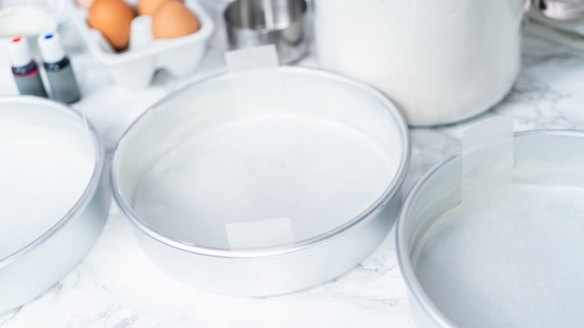The trick to lining a cake tin with baking paper

Why grease and line a cake tin? Mim and the Boys
We grease or line a cake tin to stop the batter adhering to the surface. A layer of fat forms a barrier to the surface of the tin. The baking paper serves the same role. But why take a belt-and-braces approach and do both? Well it's a simple solution to simple but nagging problem. Take a roll of baking paper and tear off a sheet. That sheet will seem to have a life of its own as it tries to return to its rolled-up shape. Same when you cut it into a circle to line a cake tin. But spray the cake tin with baking spray or lightly grease with butter, and the paper will stay in place. Plus, if there is any batter leakage, the extra grease will help prevent it from sticking.
What is the difference between Devon and fritz? M. Nyar
They are cooked sausages. They are both made with pork, salt, spices and preservatives, blended in a high-speed device to make a puree, pumped into plastic skins, sealed and cooked. A lot of water is emulsified into this puree during preparation. Devon is cheap and inoffensive, if not fatty and slightly cloying on the palate. It is the perfect sausage meat to put between two slices of fluffy white bread smeared with margarine and slathered in enough tomato sauce to cut through the fat. In WA, Devon is named "polony" and, when manufactured for the supermarkets, contains exactly the same ingredients as Devon but wears a different plastic skin. In Queensland, Devon is known as Windsor sausage, not to be confused with details of yet another royal scandal. Strasbourg, or "stras'' to most, is similar but has a coarser texture. In South Australia, the sausage is known as "fritz". Then there is South Australian bung fritz. This is a sausage loved so much by the local population that they formed the South Australian Bung Fritz Appreciation Society. Bung fritz is generally made by smaller meat processors and is a mix of beef or mutton, pork, pork fat, salt and spices plus ice or ice-cold water. The cooling effect of the cold water stops the fat from smearing as the meats are finely ground together. The water emulsifies into the fat/meat blend, making for a juicy sausage. The mix is stuffed into a sheep's appendix, tied off, smoked and cooked. The result is an aromatic sausage that is like a Germanic mortadella and brilliant with Cooper's Ale or Barossa shiraz.
Is it really necessary to hang around the soup or stock while it's cooking to skim off the froth? What happens if we don't do that? D. Hope
Traditionally the ideal stock has been clear. A skimmer is used to remove floating pieces of flesh, vegetables and albumen (protein) to which fat adheres. These are normally removed to create a clear stock. If a raft of these "impurities" settles on top of the stock, it can act as an insulating layer that can cause heat to build up. This causes the stock to roll into a boil, emulsifying fat into the stock. (Some stocks, such as ramen stock, require the fat to be emulsified.) You can pick up a wire skimmer for about $10 at an Asian grocer.
Send your vexing culinary conundrums to brainfood@richardcornish.com.au or tweet to @realbrainfood.
Appears in these collections
Restaurant reviews, news and the hottest openings served to your inbox.
Sign up- More:
- Restaurant news
